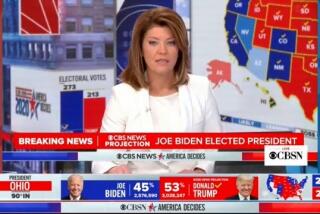Finding a ‘delicate balance’ is ‘frustrating’
NEW YORK — After two months on the job, CBS anchor Katie Couric said the hardest aspect of her new post was altering the conventional evening newscast format without turning off older viewers who historically have been the program’s most loyal audience.
“I think the most frustrating part ... has been trying to come up with something that’s new and different without alienating your core audience,” Couric said during an appearance Monday night at the Museum of Television & Radio. “It’s been such a delicate balance, and I think we’ve probably erred on the side of caution a little bit.
“I think some people expect us to change everything right away,” she added. “And I know it’s hard for me to be patient, but that’s what I’ve had to be.”
Since Couric took over the anchor desk on Sept. 5, “CBS Evening News” has entered a period of experimentation, beefing up its interviews, analytical pieces and feature stories while boiling down some of the day’s news to a compendium of headlines.
Some changes have fared better than others. “Free Speech,” a once-daily commentary segment, is now airing less frequently after a mixed reception.
Last week, the program continued to lag in third place, drawing an average of 7.76 million viewers to NBC’s 9.8 million and ABC’s 8.82 million, according to Nielsen Media Research.
CBS officials noted that their newscast has drawn 348,000 more viewers on average this season compared with last, while the other two networks have seen their audiences shrink slightly. But CBS’ season-to-date gains have been among younger viewers; the number of adult viewers older than 55 has actually declined by 3%, a drop that has worried CBS executives.
Rome Hartman, the program’s executive producer, called the newsroom “an idea lab” but noted that evolving the broadcast required a balance between change and continuity.
“It’s a venerable form with great traditions,” said Hartman, adding that he and Couric also “both feel like it’s not something that ought to be static. There’s no sense in doing this if you can’t innovate.”
During her 90-minute talk at the Museum of Television & Radio, Couric said that while she sometimes found the intense scrutiny on her work “deflating and annoying and disappointing,” she didn’t focus on the ratings.
“Seven and half million people are watching the ‘CBS Evening News,’ and it may not be as much by some as NBC and ABC, but that’s a huge number of people, more than ever watched me on the ‘Today’ show,” said the anchor, who fielded questions from museum President Pat Mitchell and college students from around the country watching via satellite. “I feel a tremendous responsibility to do the best show I can for those people, and hopefully more people will follow.”
Couric added that people who compare the current ratings with the number of people who watched the evening newscasts before the advent of cable and the Internet “look like morons.”
“It’s like, ‘Hello?’ ” she said. “That was all there was, and now obviously [with] the fragmentation of the media and our busy lives and the way we live, the days of sitting around the dinner table and watching Walter Cronkite don’t exist anymore. But I still think it’s a really valuable half-hour.”
More to Read
The biggest entertainment stories
Get our big stories about Hollywood, film, television, music, arts, culture and more right in your inbox as soon as they publish.
You may occasionally receive promotional content from the Los Angeles Times.










